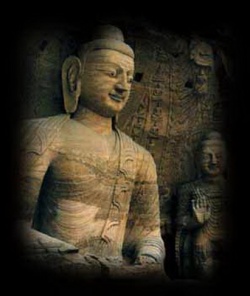Buddha statues
Buddhas are frequently represented in the form of statues.
Commonly seen designs include: *Seated Buddha,
This reclining Buddha image at Wat Suthat in Thailand depicts the spiritual leader on the verge of death.
- Reclining Buddha, as shown to the right (bottom) *Standing Buddha, as shown below *Hotei, the obese, Laughing Buddha, usually seen in China.
This figure is believed to be a representation of either a medieval Chinese monk who is associated with Maitreya, the future Buddha, and it is therefore not technically a Buddha image.
Most depictions of Buddha contain a certain number of markings, which are considered the signs of his enlightenment.
These signs vary regionally, but three are common:
Standing Buddha, ancient region of Gandhara, northern Pakistan, 1st century 1st century AD. *
A protuberance on the top of the head (denoting superb mental accuity) *
Long earlobes (denoting superb perception) * A third eye (also denoting superb perception)
The poses and hand-gestures of these statues, known respectively as asanas and mudras, are significant to their overall meaning.
The popularity of any particular mudra or asana tends to be region-specific, such as the Vajra (or Chi Ken-in) mudra, which is popular in Japan and Korea but rarely seen in India.
Others are more universally common, for example, the Varada (Wish Granting mudra is common among standing statues of the Buddha,
particularly when coupled with the Abhaya (Fearlessness and Protection) mudra.
The Buddha being shown calling for rain is a pose rarely found outside of Laos.
